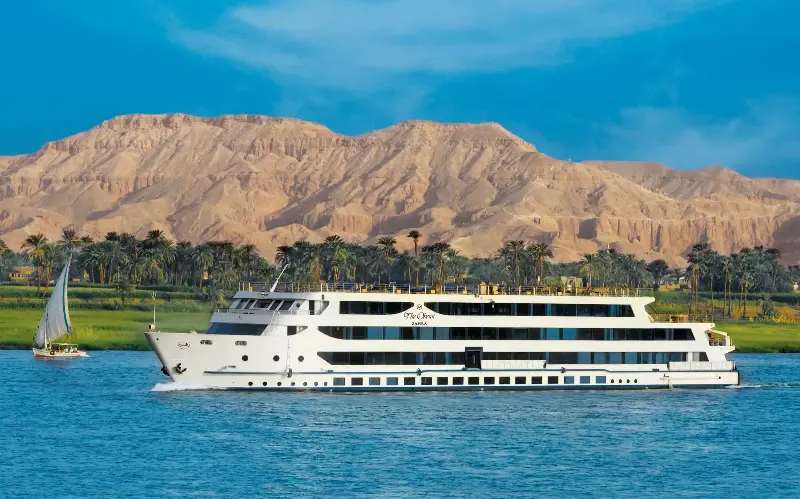
It is an inauspicious sort of beginning. Once the taxi has cut through the clutter and chaos of Luxor – the mopeds, the market stalls, the pedestrians ambling into the road at any given moment – it drops me at one of the city’s mid-range hotels. The security check is cursory, the reception is quiet, and within seconds, I am through into the patchy garden area.
And there it is, in all its glory. The Nile. The world’s longest river. Although, in this setting, fringed by a concrete dock, it is barely less scuffed than the dusty conurbation it is bisecting. In the hard light of late morning, its surface is a soupy, even sullen grey-blue – its currents swirling aimlessly, as if they have been rendered listless by the midday heat.
None of these descriptions can readily be applied to the Oberoi Philae – blithely moored at the same dock. Along with its sibling Oberoi Zahra, it is one of two luxury river-cruise vessels owned and operated by the Indian hotel group in question (although a pair of new “dahabeya” sailboats, Oberoi Melouk and Oberoi Malekat, will join this mini-fleet before the end of the year). It seems almost to hover above the water – its sides, blue and white, gleaming under the cloudless sky. Inside, 22 suites and cabins provide genteel air-conditioned sanctuaries, while the top deck – with its swimming pool, cocktail bar and assorted loungers – peers south along the line of travel we will follow in the coming days.
A journey on a ship such as this is, of course, one of the best ways to experience the many wonders of Egypt. It is not just that the deep-rooted cities and archaeological sites of the nation’s glorious ancient era sprouted – by necessity – along the Nile’s banks; it is that, on a river cruise, you can trace a route between them with knowledgeable assistance.
Waiting for me in the Philae’s lobby, Baher Zaher is an expert Egyptologist, a professional tour guide, and an affable bear of a man – his handshake as firm as his grasp of his subject. “Are you ready to come with me and see my country?” he asks, in a tone that brooks no discussion.
There is no better place to dive into this story than Luxor. While Giza and its Pyramids tend to dominate modern perceptions of Egypt’s ancient past, the onetime Thebes was arguably the centrepoint of the civilisation, acting as its capital for lengthy periods during both the “Middle Kingdom” (2040-1782BC) and “New Kingdom” (1570-1069BC) eras.
The echoes are loudest at Karnak, the temple complex on the north side of the city, where heavy footsteps were felt. Baher gestures towards the Obelisk of Hatshepsut, the 97ft (30m) column erected in honour of the New Kingdom’s great queen, who ascended the throne as regent for her stepson Thutmose III in 1479BC, and eclipsed him by retaining power for 21 years. The wall that partly hides it, Baher continues, was built by the irked pharaoh – in a peeved bid to obscure his stepmother’s legacy, after her death in 1458BC.
Then there is Ramesses II, the forceful figure who has entered popular folklore as the pharaoh of the Old Testament, all rivalry with Moses and ill-fated Red Sea crossings. His 66-year reign (1279-1213BC) is written all over Karnak’s walls, in friezes recounting his military victories, and in the staunch pillars of the Great Hypostyle Hall – which, although begun by his father Seti I, was finished on his watch (in 1224BC).
Baher’s insistence that I rip myself from my cabin’s womblike calm shortly before 5am bears fruit in a first-light arrival at the Valley of the Kings, and a chance to call on its biggest pharaonic celebrity in near-solitude. In such a context, I feel rather sorry for Tutankhamun, lying shrivelled in the corner of the room – the sparseness and smallness of the space (the archaeological theory is that his sudden, premature death saw him deposited in a tomb that had been meant for a much lesser figure) obvious without a crowd around the sarcophagus. KV62, his hole in the ground, certainly pales in contrast to some of the grander catacombs. KV8, the tomb of Merenptah (Ramesses II’s son and successor, who ruled from 1213 to 1203BC) is a palace in comparison. To wander down the steep passageway into its main chamber, every wall intricately decorated, feels like a literal descent into the underworld.
But a journey to these parts is not just a matter of death. To cruise the Nile is to witness, first hand, just how potent a lifeforce it is. You do not have to travel far – there are, after all, just 150 southbound miles between Luxor and the “end of the line” at Aswan – to realise that the river is the DNA double-helix to the Egypt of today, as well as yesterday.
An afternoon on the roof-deck puts everything into perspective, casting the Nile not as a lazy, listless river, but as a tireless African workhorse. Numerous other cruise vessels share the currents, shadowing us in our progress up-river, or slipping past us on their way north. There are boats for all budgets – not just for westerners dreaming of Cleopatra or Nefertiti, but for Egyptian tourists exploring their own country.
Smaller craft are in evidence too: fishermen who have begged or borrowed a ride, their low-slung skiffs hitched to the back of a friendly cruiser. And on the banks, all is green, the Nile extending a bountiful touch to the fields on each side – before, a mile or so beyond, the Sahara puts an end to this fecundity, reasserting its authority in sand and dirt.
And the archaeological wonders keep coming. The Temple of Edfu, on the west bank, 60 miles south of Luxor, looks as much a fortress as a place of worship, its sandstone facade as solid as when it was erected. The Temple of Kom Ombo, a further 40 miles upriver, is more ragged, some of its columns having been decapitated and reused in building work many centuries later.
Dams and temples unite when the ship arrives in Aswan. Egypt’s most southerly city is the “end of the line” for the ship in that, while the Nile continues, over the border into Sudan (and, in various guises, into Ethiopia and Uganda), the city’s Low and High Dams – completed in 1902 and 1970 respectively – preclude further navigation.
The High Dam, in particular, is astonishing, its 2.5-mile ridge of stone delivering epic views across Lake Nasser, the reservoir that was born of its construction. But the consequences were less serene for the aptest possible end-point for a cruise on the Oberoi Philae – its namesake temple. Damned to be drowned if it remained in position, between the dams, it was painstakingly transplanted to an adjacent islet over three wearying years.
The effort was worth it. And, in truth, Philae had suffered a more invasive disruption much earlier in its history. Tucked into the outer reaches of ancient Egyptian territory, it was the final temple devoted to the old gods, as regime change pulled down the pantheon. Remote enough that it could ignore a changing world, it continued in its devotion to Isis and Osiris long after the Roman Empire had formally adopted Christianity as its religion (via the Edict of Thessalonica), in 380AD. In fact, the curtain did not fall until 537AD, when the temple – and rituals that were now considered to be satanic – was closed down.
But even then, there was resilience.
Baher leads me to a back chamber, missed by the censors of the sixth century, where a splendid frieze of Isis escaped the chisels which disfigured her elsewhere in the complex – demonstration that a history as remarkable as ancient Egypt’s is impossible to suppress.
Essentials
Oberoi offers four- and six-night Nile cruises – from Luxor to Aswan, or vice-versa – aboard the Oberoi Philae (0091 11 6911 0606; oberoihotels). An eight-night holiday to Egypt, featuring a four-night Oberoi Philae cruise, as well as time in Cairo (including tours of the Grand Egyptian Museum and the Pyramids), costs from £6,949 per person, including all flights and transfers (01993 838 410; audleytravel).
